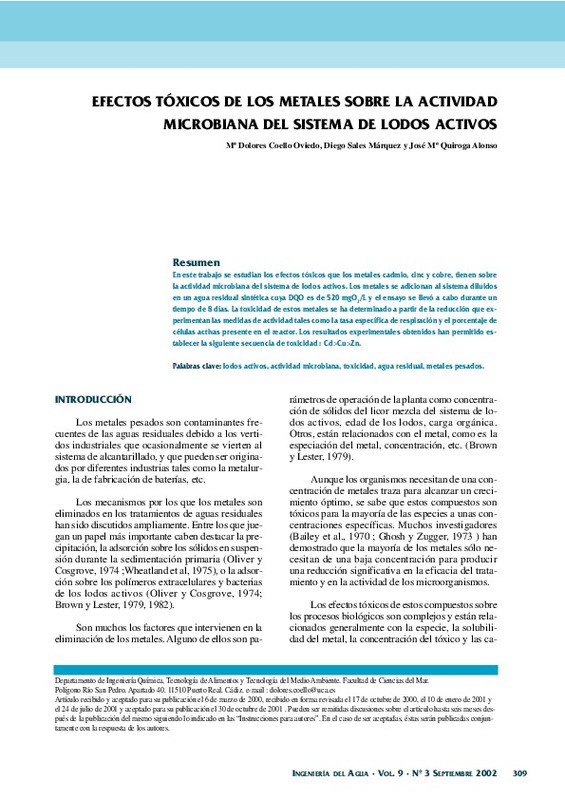ALIBHAI, K.R.K., MEHROTRA, I. y FOSTERC.F. (1985). Heavy metal binding to digested sludge. Wat. Res. 19, 1483-1488.
APHA; AWWA; WPCF (1989). Métodos Normalizados. Para el análisis de aguas potables y residuales. Editorial Díaz de Santos, S. A., Edición en español (1990).
BAILEY, D.A; DORRELLJ.J. y ROBINSON K.S. (1970) The influence of trivalent chromium on the biological treatment of domestic sewage. Wat. Pollut. Control 69, 100-110.
[+]
ALIBHAI, K.R.K., MEHROTRA, I. y FOSTERC.F. (1985). Heavy metal binding to digested sludge. Wat. Res. 19, 1483-1488.
APHA; AWWA; WPCF (1989). Métodos Normalizados. Para el análisis de aguas potables y residuales. Editorial Díaz de Santos, S. A., Edición en español (1990).
BAILEY, D.A; DORRELLJ.J. y ROBINSON K.S. (1970) The influence of trivalent chromium on the biological treatment of domestic sewage. Wat. Pollut. Control 69, 100-110.
BATTISTONI P., FAVA G., y RUELLO, M.L. (1993). Heavy metal shock load in activated sludge uptake and toxic effects. Wat. Res. 27, 821-827.
BROWN, M.J. y LESTER J. N. (1979) Metal removal in activated sludge: the role of bacterial extracellular polymers. Wat. Res. 13, 817-837.
BROWN, M.J. y LESTER J. N. (1982). Role of bacterial extracellular polymers in metal uptake in pure bacterial culture and activated sludge-II. Wat. Res. 16, 1549-1560.
CARDINALETTI, M.M ZITELLI, A., VOLPI GHIRARDINI, A. y AVEZZÚ, F (1990). Population dynamics of the microfauna in an activated sludge plant treating domestic and industrial effluents. Inquinamento 32,62-68.
CHANG S. Y., HUANG, J.C. y LIU, Y.C. (1986). Effects of Cd (II) and Cu (II) on a biofilm system. J. Environ. Engng. 112, 94-104.
DILEK, F.B. y YETIS. U. (1992). Effects of heavy metals on activated sludge process. Wat. Sci. Technol. 26, 801-813.
GHOSH, M.M. y ZUGGER P.D. (1973). Toxic effects of mercury on the activated sludge process. J. Wat. Pollut. Control Fed. 45, 424-433.
GRIEBE, T., SHAULE, G. y WUERTZ, S. (1997). Determination of microbial respiratory and redox activity in activated sludge. Journal of Industrial Microbiology & Biotechnology 19, 118-122.
HARTZ, K.E., ZANE, A.T. y BHAGAT, S.K. (1985) The effect of selected metals and water hardness on the oxygen uptake of activated sludge. J. Wat. Polut. Control Fed. 57, 942-947.
KLAPWIJK, A., DRENT, J. y STEENVOORDEN VAN J.H.A.M.
(1974) A modified procedure for the TTC-dehydrogenase test in activated-sludge. Water Res. 8, 121-125.
KUNZ, R.G., GIANELLI, J.F. y STENSEL, H.D. (1976) Vanadium removal from industrial waste waters. J. Wat. Pollut. Control Fed. 48, 762-770.
MADONI, P. (1994). A sludge biotic index (SBI) for the evaluation of the biological performance of activated sludge plants based on the microfauna analysis. Water Res.28 (1): 67-75.
MADONI, P, DAVOLI, D., GORBI, G. y VESCOVI, L. (1996). Toxic effect of heavy metals on the activated sludge protozoan community. Wat. Res 30 (1) 135-141.
NELSON, P. O., CHUNG, A.K. y HUDSON, M.C. (1981). Factors affecting the fate of heavy metals in the activated sludge process. J. Wat. Pollut. Control Fed. 48, 1940-1947.
NEUFELD, R.D. (1976). Heavy metals induced defloculation of activated sludge. J. Wat. Pollut Control Fec. 48, 1940-1947.
OLIVER, B. G. y COSGROVE, E.G. (1974). The efficiency of heavy metal removal by a conventional activated sludge treatment plant. Wat. Res. 8, 869-874.
RUDD, T., STERRITT, R.M. y LESTER, J.N. (1983). Stability constants and complexation capacities of complexes formed between heavy metals and extracellular polymers from activated sludge. J. Chem. Tecnol. Biotecnol. 33a, 374-380.
RUDD, T., STERRITT, R.M. y LESTER, J.N. (1984). Formation and conventional stability constants of complexes formed between heavy metals and bacterial extacellular polymers. Wat. Res. 18, 379-384.
SCHAULE, G; FLEMMING, H-C; RIDGWAY, H.F. (1993). Use of 5-Cyano-2,3-Ditolyl Tetrazolium Chloride for Quantifying Planktonic and Sessile Respiring Bacteria in Drinking Water. Applied and Environmental Microbiology 11 (59): 3850-3857.
SHUTTLEWORTHK.L. y UNZ, R.F. (1988). Growth of filamentous bacteria in the presence of heavy metals. Wat. Sci. Technol. 20, 485-487.
WHEATLAND, A. B., GLEDHIL, C. y O ́GORMAN, J.V. (1975). Developments in the treatment of metal-bearing effluents. Chem. Ind. 32, 632-638.
[-]








